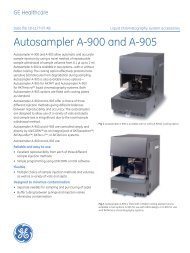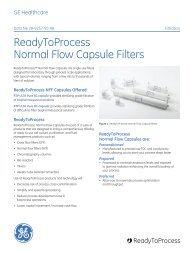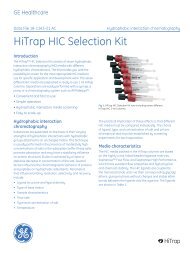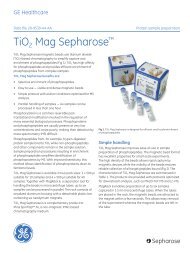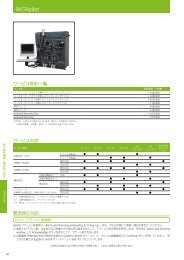A new IMAC medium for scaling up purification of Histidine-tagged ...
A new IMAC medium for scaling up purification of Histidine-tagged ...
A new IMAC medium for scaling up purification of Histidine-tagged ...
You also want an ePaper? Increase the reach of your titles
YUMPU automatically turns print PDFs into web optimized ePapers that Google loves.
Material and Methods<br />
Chromatography conditions were, unless otherwise stated:<br />
Medium: Ni Sepharose 6 Fast Flow pre-packed in 1-ml<br />
and 5-ml HisTrap FF, and 20-ml HisPrep FF<br />
16/10 columns<br />
Samples: Cell extracts from E. coli or P. pastoris were<br />
clarified by centrifugation and filtration;<br />
containing 0.5 M NaCl and imidazole at a<br />
concentration appropriate <strong>for</strong> each target<br />
protein.<br />
Flow rate: 1 ml/min<br />
Binding buffer: 20 mM sodium phosphate, 0.5 M NaCl,<br />
x mM imidazole, pH 7.4 (x = optimized <strong>for</strong><br />
each target protein)<br />
Optimization: The optimal imidazole concentration to<br />
obtain the best purity and yield differs<br />
from protein to protein. A small number <strong>of</strong><br />
screening runs, including a run with a linear<br />
imidazole gradient from 5 mM, will facilitate<br />
finding a suitable imidazole concentration<br />
<strong>for</strong> optimal results.<br />
Elution buffer: 20 mM sodium phosphate, 0.5 M NaCl,<br />
500 mM imidazole, pH 7.4<br />
Purifications were per<strong>for</strong>med on ÄKTAexplorer 10 or<br />
100 systems. Elution was done either with a step or a linear<br />
imidazole gradient. SDS-PAGE was per<strong>for</strong>med with<br />
ExcelGel SDS Gradient 8–18 Gels.<br />
Purifications <strong>of</strong> <strong>Histidine</strong>-<strong>tagged</strong> proteins<br />
in the presence <strong>of</strong> DTT<br />
Column: HisTrap FF 1-ml<br />
Sample: (<strong>Histidine</strong>) 6<br />
-<strong>tagged</strong> Maltose Binding Protein in E. coli extract<br />
(conc. ~1 mg/ml, M r<br />
~43 000)<br />
Sample volume: 7 ml<br />
Binding buffer: 2 or 5 mM DTT, 20 mM sodium phosphate, 25 mM imidazole,<br />
500 mM NaCl, pH 7.4<br />
Elution buffer: 2 or 5 mM DTT, 20 mM sodium phosphate, 500 mM imidazole,<br />
500 mM NaCl, pH 7.4<br />
Flow rate: 1 ml/min<br />
Note: A blank run without DTT was per<strong>for</strong>med be<strong>for</strong>e the sample application.<br />
Six repeated <strong>purification</strong>s<br />
without stripping, cleaning or Ni 2+ recharging the column<br />
Column: HisTrap FF 1-ml<br />
Sample: (<strong>Histidine</strong>) 6<br />
-<strong>tagged</strong> Maltose Binding Protein in E. coli extract<br />
Sample volume: 7 ml<br />
Binding buffer: 20 mM sodium phosphate, 5 mM imidazole, 500 mM NaCl, pH 7.4<br />
Elution buffer: 20 mM sodium phosphate, 5–200 mM imidazole, 500 mM NaCl,<br />
pH 7.4 (linear gradient)<br />
Flow rate: 1 ml/min<br />
M r<br />
97 000<br />
66 000<br />
45 000<br />
30 000<br />
20 100<br />
14 400<br />
Fig 2. SDS-PAGE analysis under nonreducing conditions <strong>of</strong> pooled fractions<br />
from different runs.<br />
Table 1. Summary <strong>of</strong> <strong>purification</strong> results from the six repeated <strong>purification</strong><br />
runs on Ni Sepharose 6 Fast Flow shown in Figure 2.<br />
Run Amount eluted Yield (%) Molar ratio<br />
protein (mg)<br />
Ni 2+ /protein<br />
1 7.5 88 0.14<br />
2 7.4 87 0.11<br />
3 7.4 87 0.08<br />
4 7.2 85 0.07<br />
5 7.5 88 0.07<br />
6 7.5 88 0.06<br />
Results:<br />
1 2 3 4 5 6 7<br />
Lane 1: LMW markers<br />
Lane 2: Run 1<br />
Lane 3: Run 2<br />
Lane 4: Run 3<br />
Lane 5: Run 4<br />
Lane 6: Run 5<br />
Lane 7: Run 6<br />
• Excellent reproducibility in purity and recovery without<br />
the need <strong>for</strong> stripping, cleaning, or Ni 2+ recharging the<br />
<strong>medium</strong>.<br />
• Low Ni 2+ -leakage during <strong>purification</strong>s (low leakage<br />
minimizes potential problems such as Ni 2+ induced<br />
oligomerization and precipitation <strong>of</strong> target protein,<br />
and loss <strong>of</strong> binding capacity).<br />
M r<br />
97 000<br />
66 000<br />
45 000<br />
30 000<br />
20 100<br />
14 400<br />
1 2 3 4 5<br />
Lane 1: LMW markers<br />
Lane 2: Run 1, 2 mM DTT<br />
Lane 3: Run 2, 2 mM DTT<br />
Lane 4: Run 3, 5 mM DTT<br />
Lane 5: Run 4, 5 mM DTT<br />
Fig 1. Purity and recovery <strong>of</strong> repeated <strong>purification</strong> runs on Ni Sepharose 6<br />
Fast Flow without Ni 2+ recharging.<br />
Results:<br />
• Purity and recovery were not affected by DTT.



![[PDF] マニュアル GradiFrac](https://img.yumpu.com/22037825/1/190x253/pdf-gradifrac.jpg?quality=85)
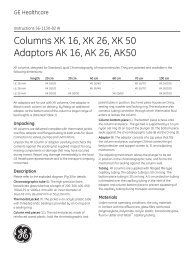
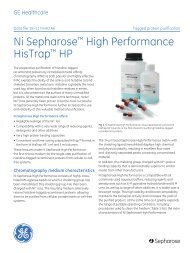
![[PDF] Sample preparation for analysis of protein, peptides and ...](https://img.yumpu.com/21549715/1/190x257/pdf-sample-preparation-for-analysis-of-protein-peptides-and-.jpg?quality=85)
![[PDF] Data File: rProtein A Sepharose Fast Flow](https://img.yumpu.com/21549316/1/190x253/pdf-data-file-rprotein-a-sepharose-fast-flow.jpg?quality=85)
![[PDF] MBP-tagged protein purification](https://img.yumpu.com/21548507/1/184x260/pdf-mbp-tagged-protein-purification.jpg?quality=85)
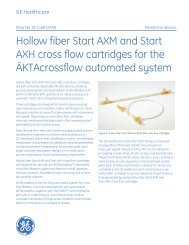
![[PDF] AKTA ready system Data file](https://img.yumpu.com/21540925/1/190x253/pdf-akta-ready-system-data-file.jpg?quality=85)
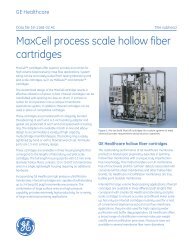
![[PDF] Data File - rProtein A/Protein G GraviTrap](https://img.yumpu.com/21539052/1/190x253/pdf-data-file-rprotein-a-protein-g-gravitrap.jpg?quality=85)
